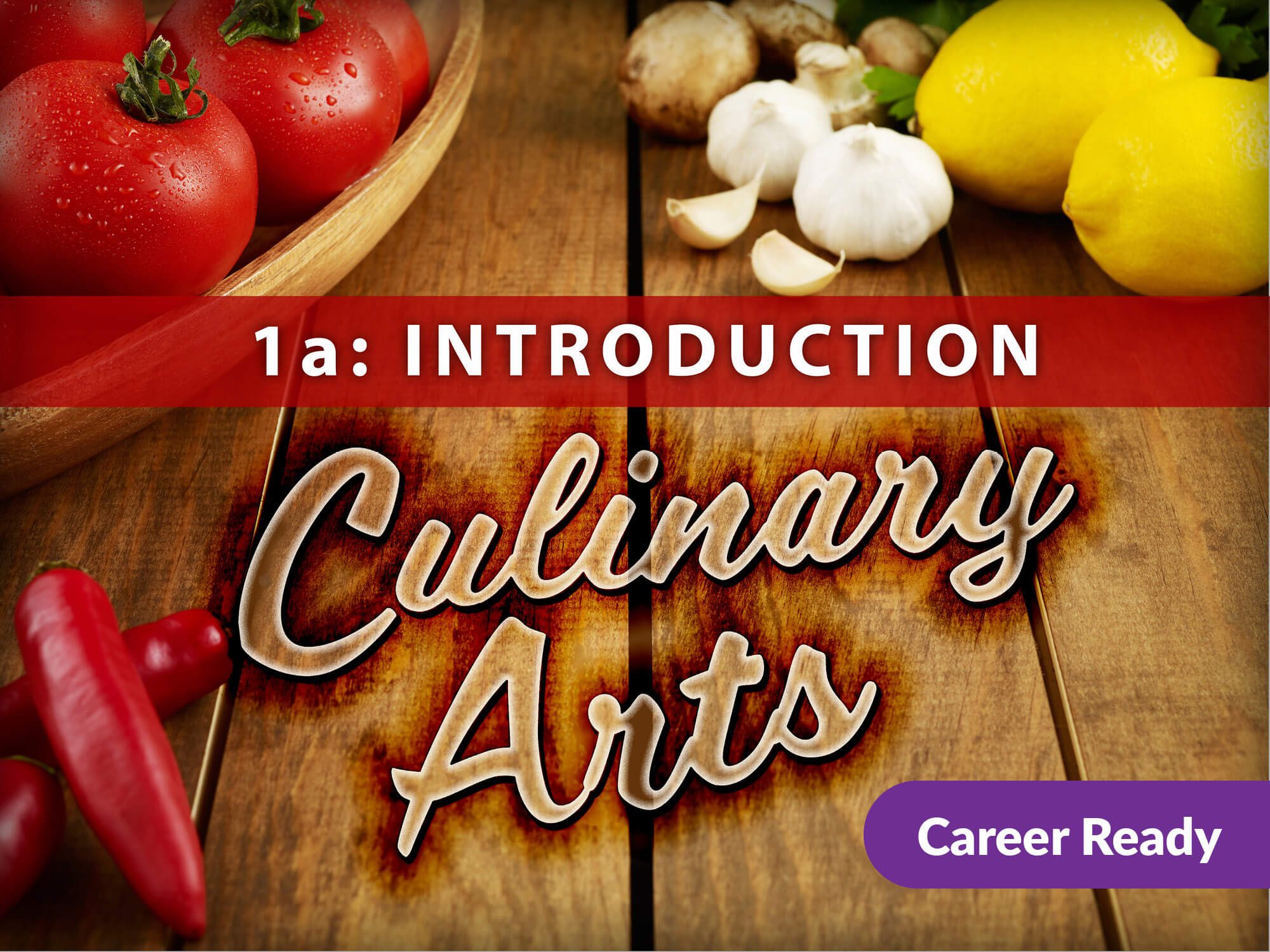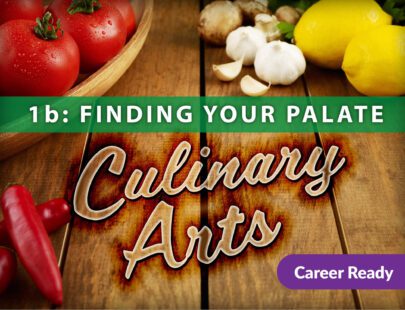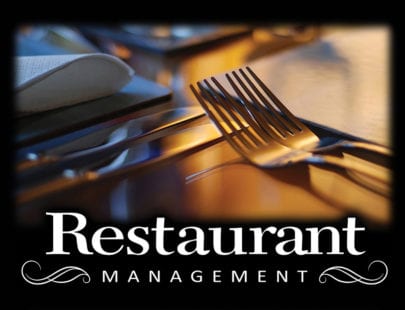
Culinary Arts 1a: Introduction
Thinking of a career in the foodservice industry or looking to develop your culinary skills? Explore basic cooking and knife skills while preparing you for entry into the culinary world. Discover the history of food culture, food service, and global cuisines while learning about food science principles and preservation. Prepare for your future by building the professional, communication, leadership, and teamwork skills that are crucial to a career in the culinary arts.
Units at a Glance
Unit 1: The Safe Kitchen
The culinary process of cooking, baking, and preparing food is the only edible art form in the world, which means it is a pretty unique field of study. This characteristic also makes it a particularly enjoyable and valuable skill to learn. Who doesn’t want to eat their own creation? But before you even think of tying on an apron, there are a few kitchen safety rules you won’t want to miss, especially if you hope to enjoy your delicious “art” free from cuts, burns, and other cooking-related injuries. Once you understand how to handle any accidents or unexpected emergencies that might pop up in the kitchen, you will be one step closer to cooking up your own culinary masterpiece.
What will you learn in this unit?
- Discuss the dos and don’ts of basic cooking
- Describe standard procedures for chemical hazard control
- Explain the importance of safety procedures in the workplace
- Identify and use proper first aid procedures for kitchen-related accidents and injuries
Unit 2: Knife Skills
There’s a reason why the television show “Iron Chef” uses two giant knives as their symbol. Not only is it recognizable, it instantly tells the viewer what is most valuable and vital in the kitchen of the culinary gods—their chef’s knives! From the massive cleaver to the delicate boning knife, there is a special cutting tool for every recipe in the cooking world. To use and maintain these sharp blades properly, free from injury and stress, certainly takes some talent, but it is well worth the effort. Because once you have the knowledge of knives under your apron straps, you’re ready to start cooking with fire.
What will you learn in this unit?
- Discuss the importance of proper knife safety
- Explain and demonstrate basic knife techniques
- Identify and explain the four key knives in a professional kitchen
- Describe various cutting methods and the role they play in food preparation
Unit 3: Food Safety
Food is a wonderful thing. It is delicious, nutritious, and enjoyable—but sadly, it can also be dangerous if not handled properly. And for individuals hoping to find success in the culinary world, understanding areas like sanitation, storage, and waste management in a kitchen environment is the only way to fight this danger. It is not possible to whip up edible masterpieces for people to enjoy until you recognize the many ways bacteria and foodborne illnesses can ruin your efforts, not to mention make people sick. That’s why all chefs, no matter how talented and famous they are, make all-around cleanliness and proper food handling their top priority.
What will you learn in this unit?
- Apply sanitation standards to the kitchen environment
- Identify the key elements of foodborne illnesses and how to prevent them
- Explain the process and importance of waste management in the food industry
- Describe the inventory process and how it affects food preparation and safety
Unit 4: Cuisine and Culture
Any time you want to really understand something, you need to start at the beginning. And in the case of food, the beginning extends back hundreds of thousands of years to a time when an open fire was the only method of cooking. But through centuries of culinary “trial and error,” we have finally arrived at a point where we understand food better than ever. Science and technology have contributed greatly to our knowledge of food, always building on the existing foundation of culture and tradition. Using both older approaches and beliefs along with new findings, chefs are now able to explore the world of edible ingredients like never before.
What will you learn in this unit?
- Explain food science and how it affects the culinary world
- Identify various cooking methods and how they affect food
- Describe different cuisines and their relationship to culture and history
- Differentiate between proteins and other food groups
Unit 5: Garde Manger: The Cold Kitchen
If you are interested in finding a unique place in the culinary world where your artistry can shine, the cold kitchen environment of the garde manger might be the place for you. From classic mixed green salad to avocado crabmeat soup to seared cardamom duck with poached tangerine relish, this realm of food preparation is cool for many reasons. Not only is the history of the garde manger a long and fascinating one, it has set a foundation for artistry and culinary achievement that is second to none. Using skills and many tricks of the trade, these chefs are able to produce all sorts of chilled delights that are appealing to both the senses and the taste buds. Fresh, chilled, sweet, tangy, spicy, creamy, crunchy, the beauty of the garde manger proves fire isn’t the only way to cook.
What will you learn in this unit?
- Explain the history and significance of the garde manger
- Describe the types of dishes prepared in the cold kitchen
- Identify proper preservation methods, both new and old
- Detail the basic equipment in the garde manger
Unit 6: The Principles of Food
There is a lot more to food than meets the eye—and the mouth. Every ingredient written up in a menu and served up on a plate has its own unique set of characteristics, mannerisms, and preferences, much like a person. Further, every ingredient, down to the last potato peel, is associated with a monetary cost of some kind, which is why chefs must learn to straddle the world of art and finance. On one side, they are engaging with food creatively, while on the other side, they must also look at the entire process with a practical eye. They must know how to craft a menu without losing sight of their budgetary goals, always shooting for the best value with the most yield. Striking this balance is critical in the food service industry, where things must be both delicious and affordable.
What will you learn in this unit?
- Describe a standardized recipe and its significance to the food industry
- Perform cost analysis on an original recipe
- Explain the application of weights and measures in a food service setting
- Discuss the principles of food preparation
Unit 7: Professionalism
Entering the world of cuisine is about far more than just cooking. It has its own rich history, language, and professional hierarchy of positions—almost like a mini-kingdom. With the executive chef as the royal monarch, all the other roles unfold beneath to create a network of individuals collaborating as a team to deliver up the best possible food from their kitchen. And being part of this kingdom demands knowledge of its unique rules and expectations, many of which are unwritten and unspoken. But don’t be fooled—the cultural climate of a professional kitchen is as real as fire, and it will burn you if don’t learn how to get along, communicate, and most importantly, bring your personal best every single time you pick up a pan. For those who can handle the heat, it is one of the most exciting and fulfilling places on earth.
What will you learn in this unit?
- Discuss the history of food service and some of its contributing figures
- Describe the various roles of the kitchen hierarchy
- Define professionalism and its key tenets
- Explain the importance of oral and written communication in the workplace
Unit 8: Leadership, Teamwork, and Ethics
No one said being a chef is a simple profession. It is a world filled with rules, challenges, and expectations, all of which have to be honored and met. Despite its history, the professional kitchen is not really a traditional workplace. It’s dangerous and filled with fire and sharp objects. It’s a place where tempers run high and performance is everything. It can be a tiring, stressful, and hectic environment. And these realities can sometimes heighten the professional drama and make certain challenges seem insurmountable. But what’s important to remember is that life in the kitchen often mirrors the challenges of daily life. People yell, and things sometimes get intense. There are a diverse number of people, backgrounds, and ideas. Things get messed up, and then they get fixed. Just like life. That’s why people in food service depend heavily on the strength of their leaders and their team to get the job done, no matter what. Working through personal and professional challenges in a fast-paced environment is an adrenaline rush like no other, and many of the best chefs in the world will tell you they wouldn’t trade it for anything.
What will you learn in this unit?
- Describe effective leadership in the workplace
- Explain the role of teamwork in the kitchen
- Discuss the importance of team diversity
- Identify and exhibit professional work ethics
Required Materials
- Computer with:
- Internet access
- Word processing program
- Slideshow presentation program
- Video recording device
- Friend and/or family member to help act-out scenarios in videos
- Props for Videos (fake items may be subbed for real ones):
- First-aid tools and materials (band-aids, gauze, ointment, antiseptic, etc.)
- Plastic knife, butter knife, or basic dinner knife
- Food item to practice knife skills on like chilled stick of butter
- Kitchen with appliances like a sink, stove, refrigerator, etc.
- Pots and pans for washing demonstration
- Four boxes or buckets to use as sinks
- Dishwasher or an item to stand in for a dishwasher
- Chemicals used for dishwasher cleaning (or pictures of them)
- Meat thermometer
- Gloves, hair restraints, closed-toe shoes, apron, etc. – all for demonstrating proper kitchen hygiene
- Various foods to use in video demonstration of dry heat and moist heat cooking methods
- Salad and salad dressing ingredients
- Vegetable and starch ingredients
- Cold cooking tools



